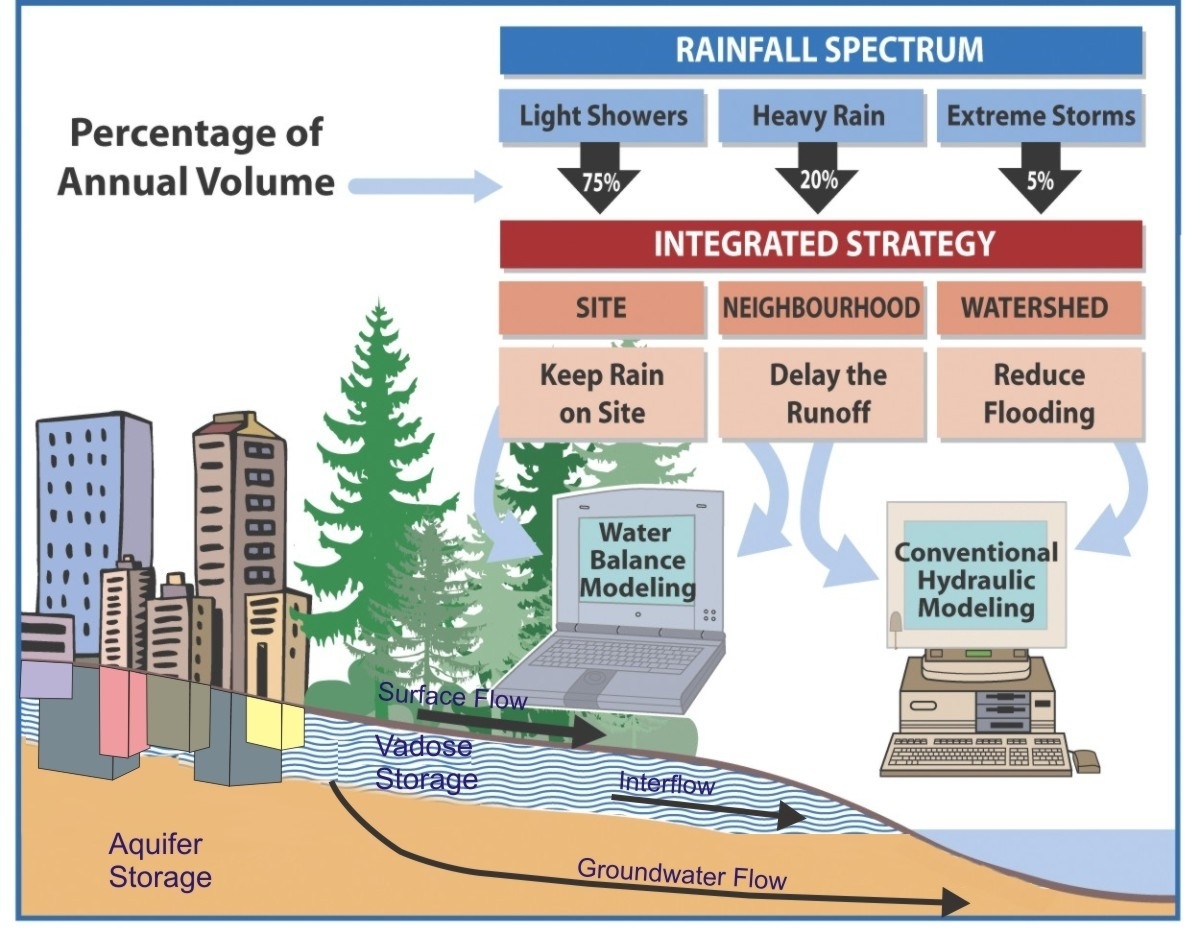Rainwater Management in the 21st Century: “We have moved beyond MAR in British Columbia,” says Kim Stephens
The Goal is to Protect Stream Health
“In 2002, the Stormwater Planning: A Guidebook for British Columbia introduced a science-based methodology for setting performance targets for managing RUNOFF VOLUME and RUNOFF RATE, states Peter Law (formerly with the Ministry of Environment), Chair of the 2002 Guidebook Steering Committee.
 “We linked the use of performance targets to the Integrated Strategy for Managing the Rainfall Spectrum; and we defined the rainfall spectrum in terms of three tiers, with each tier corresponding to a component of the Integrated Strategy, namely: rainfall capture at the site scale, runoff control at the neighbourhood scale and flood mitigation at the watershed scale.”
“We linked the use of performance targets to the Integrated Strategy for Managing the Rainfall Spectrum; and we defined the rainfall spectrum in terms of three tiers, with each tier corresponding to a component of the Integrated Strategy, namely: rainfall capture at the site scale, runoff control at the neighbourhood scale and flood mitigation at the watershed scale.”
 “We referenced the three tiers to a value that we defined as the Mean Annual Rainfall (MAR),” continues Ted van der Gulik (Ministry of Agriculture), Chair of the Water Balance Model Partnership and a member of the 2002 Guidebook Steering Committee. “We introduced the MAR concept in order to facilitate a paradigm-shift in the way rainfall is viewed.”
“We referenced the three tiers to a value that we defined as the Mean Annual Rainfall (MAR),” continues Ted van der Gulik (Ministry of Agriculture), Chair of the Water Balance Model Partnership and a member of the 2002 Guidebook Steering Committee. “We introduced the MAR concept in order to facilitate a paradigm-shift in the way rainfall is viewed.”
“As our understanding of what is achievable through ‘RAINwater management’ has grown, we have moved beyond the MAR concept. It was in addressing the relationship between ‘rainfall capture’ and ‘runoff rate control’ that the Beyond the Guidebook initiative picked up where the Guidebook left off in 2002,” explains Kim Stephens, Guidebook Project Manager and now Executive Director of the Partnership for Water Sustainability in British Columbia.
Moving Beyond MAR
“By 2007, we had become concerned about the way MAR was either being misinterpreted or misunderstood by various regulators and drainage practitioners in British Columbia. Because they were applying it as a prescriptive solution, they had lost sight of the goal – which is to protect stream health. And in so doing, they were not thinking about the nature of the relationship between rainwater runoff and flow in streams, and the implications for stream erosion and sedimentation. These are processes that impact on stream health,” explains Kim Stephens.
“Our original rationale for introducing MAR in 2002 was to provide consistency with the Land Development Guidelines. When they were  released in 1992, the regulatory focus was on managing storms with a 2-year period. Statistically speaking, this is approximately equivalent to the MAR. Because the concept of the Rainfall Spectrum was new territory for drainage engineers, the MAR established a point of departure that was familiar to them so that they would readily make the transition to a new way of thinking – and that is, how to manage all 180 ‘rainfall-days’ in a year, not just one or two extreme storm events.”
released in 1992, the regulatory focus was on managing storms with a 2-year period. Statistically speaking, this is approximately equivalent to the MAR. Because the concept of the Rainfall Spectrum was new territory for drainage engineers, the MAR established a point of departure that was familiar to them so that they would readily make the transition to a new way of thinking – and that is, how to manage all 180 ‘rainfall-days’ in a year, not just one or two extreme storm events.”
“Introduction of the MAR focused attention upon the site level while assuming there would be benefits to the watershed and streams. In 2007, the Beyond the Guidebook initiative addressed the need to take a closer look at the relationship between the rainfall spectrum and the flows actually entering streams from the watershed.”
“Over the past decade, ongoing development and evolution of the Water Balance Model has enabled us to move beyond the simplistic MAR concept and address the interaction of runoff – both volume and duration – with the physical aspects considered important to the aquatic environment,” concludes Kim Stephens.
TO LEARN MORE about why and how the Water Balance Model is a tool to correlate runoff volume management with stream erosion and water quality outcomes. click on Application of the “DFO Urban Stormwater Guidelines” has evolved over the past decade to protect stream health to read a story posted on the Water Bucket website.


